News In Slow French

Summary
News in Slow French offers three different levels of content (beginner, intermediate, and advanced) with lots of different features for each. I’m a huge fan of what’s included at the intermediate level but a bit less enthusiastic about the content at the beginner and advanced levels. That’s not to say those levels are bad, they aren’t by any means, but the material available for intermediate level learners is really fantastic. Much more than simply current events narrated at a slower pace, News in Slow French is comprensive, engaging, fun, and effective.
It often doesn’t feel like you’re studying without sacrificing on quality.
The depth and unique manner in which they teach grammar and expressions is really impressive.
Although it’s not cheap, there’s more content than you may initially realize.
I Like
- The manner in which current events are talked about makes them really engaging to listen to.
- The huge catalog of grammar and expressions lessons age very well, providing a ton of study material.
- Grammar and expressions are first used naturally in a conversation, only to be explained later, making learning them feel much more natural.
I Don’t Like
- The beginner and advanced lessons aren’t quite as good as the intermediate level.
- Their app is very basic and doesn’t include the courses, so you may prefer using a mobile browser instead.
- Most of the content doesn’t require you to use the French you’ve learned.
Price
There’s a 7-day free trial for new subscribers, then the price is $19.90/month. There’s also an option to prepay for up to 12 months at a time, which doesn’t affect the monthly price.
News in Slow French is an online program that aims to provide useful content for French language learners of all levels. Some of these levels are better than others.
News in Slow French is a really good resource, though I was much more impressed with what’s included in the intermediate level compared to the beginner and advanced levels. None of them are bad, but the intermediate level is fantastic.

This review will be very detailed, highlighting everything included within each level, starting with the courses.
Beginner Course – Getting up to Speed (G.U.T.S)

News in Slow French’s beginner course is pretty unique compared to most other French courses you’ll find.
For starters, it’s structured as a play, and each lesson is an act in the play.
While this sounds unusual and is somewhat, it feels a lot more normal since one of the main characters in the play is a French teacher, and the other characters are her students.
The lessons start from zero, with the absolute basics being taught first and progressing to more challenging content as you move through the course.
The hosts mix together English and French into the conversations naturally, adding in some humor, culture, and telling a story that builds up in each act.
The course clearly progresses in difficulty as more French and less English are used as you make your way through it.
In total, there are 30 acts in the beginner course. Each act contains the following sections – Opening, Hello Again, Grammar, Expressions, Pronunciation, Quizzes, and Closing.
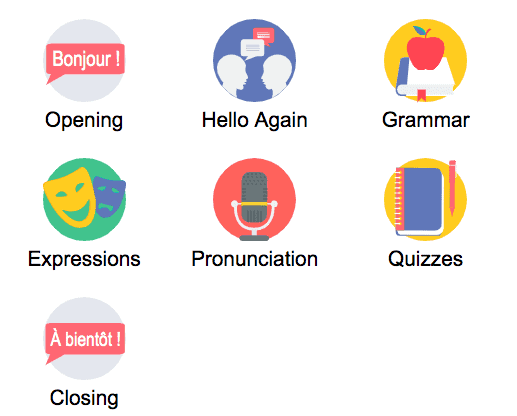
Opening
The opening is a brief introduction to the act. It lasts less than a minute and the narrator just gives you a brief introduction as to what will be included in the lesson. You’re encouraged to study the lessons and flashcards before moving onto the dialogues.
Flashcards
Although I’m a big fan of News in Slow French, their flashcards section is seriously lacking. I don’t think flashcards would really be the correct word for these. Basically, it’s just a PDF download of a vocabulary list.
This is fine for getting acquainted with the vocabulary, but I wouldn’t recommend trying to go through the word list and memorize the words that way. You’ll encounter these words later in the lesson so I think a quick read-through should be sufficient.
Hello Again
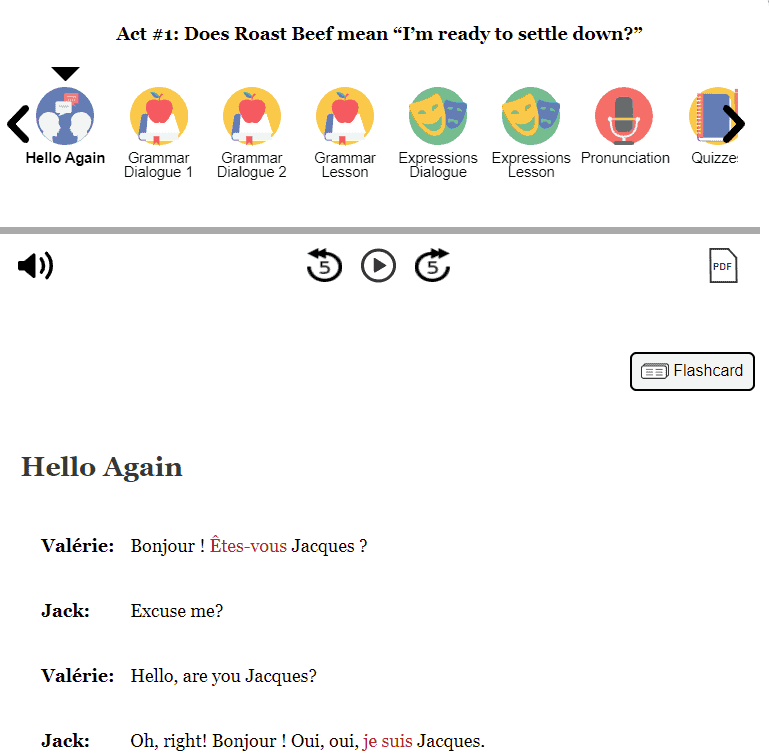
This section consists of a dialogue between two of the characters in the play. The audio typically lasts around five minutes long and you can also follow along with the interactive transcripts. The French words that are written in red can be hovered over to show their English translation.
This dialogue mixes together English and French. You get to know the characters, and the story comes together nicely. You get to hear one of the French students putting together what they learn to express themselves. It’s also very clear that as you make your way through the lessons, English is used less and more French is spoken.
One weakness here is that it can be a pretty passive way to study as you’re mainly listening and not producing the language. This is especially evident when compared with a resource like Pimsleur that gets you speaking often from the beginning.
Grammar Dialogues and Lesson
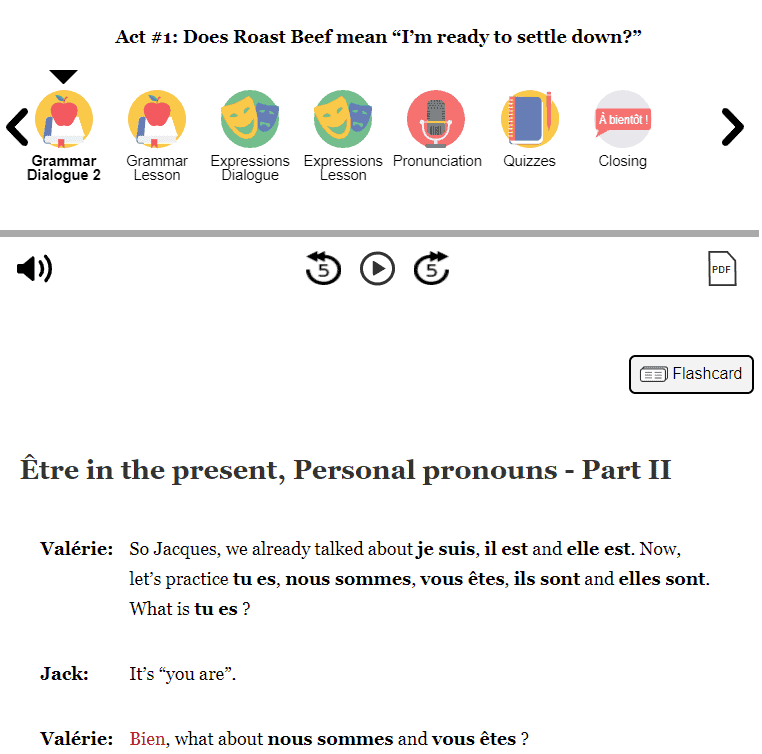
Next up in the lessons is the grammar section which consists of two dialogues and a written lesson. In the dialogues, the teacher will explain the grammar points with the students and prompt them to combine what they’ve learned with what they already know. Each dialogue typically lasts around five minutes or so, and you can follow along with the dialogue using their interactive transcripts.
The structure is fairly similar to Coffee Break French with the student learning alongside the listener. Although, in this G.U.T.S. program, it’s a lot more scripted, with the characters’ stories playing a role in how the dialogues come together.
After the dialogues is the grammar lesson. This is a written explanation of the grammar and is pretty similar to what you might expect to find in any textbook. Although it’s not the most exciting thing ever, it’s definitely useful.
Expressions DIalogue and Lesson
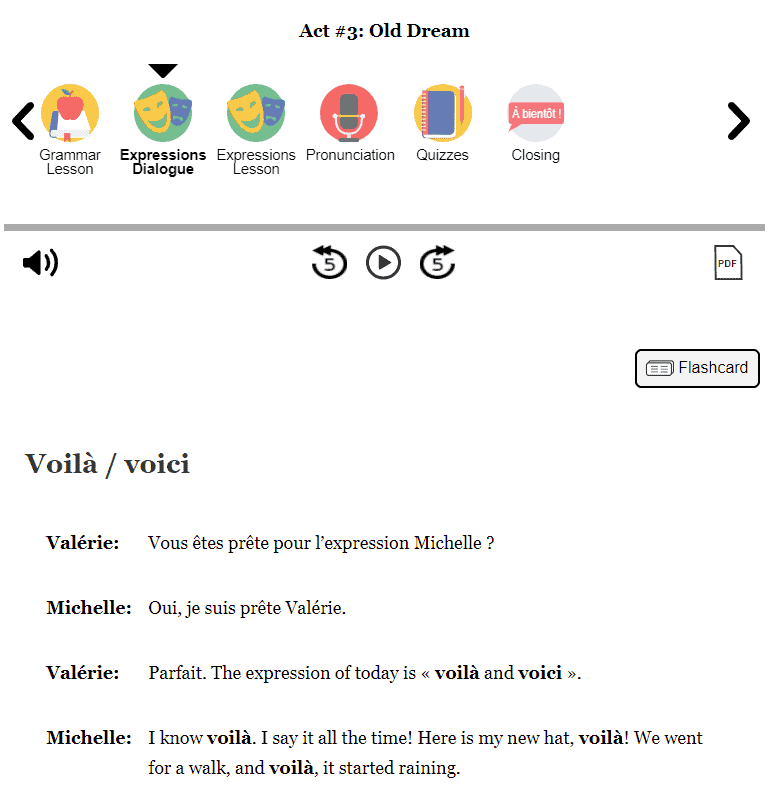
In this part of the episode, the teacher will explain a French expression to the student. Here, there’s a dialogue that typically lasts around five minutes, as well as a written lesson.
The format is quite similar to what we’ve encountered earlier, with the teacher and student having a conversation that you can listen to and follow along with using the transcripts. The student will ask questions along the way and practice using the expression within different contexts while intertwining parts of their character’s personality and story.
The written lesson just explains the expression a bit more while giving examples of when and how to use it.
Pronunciation
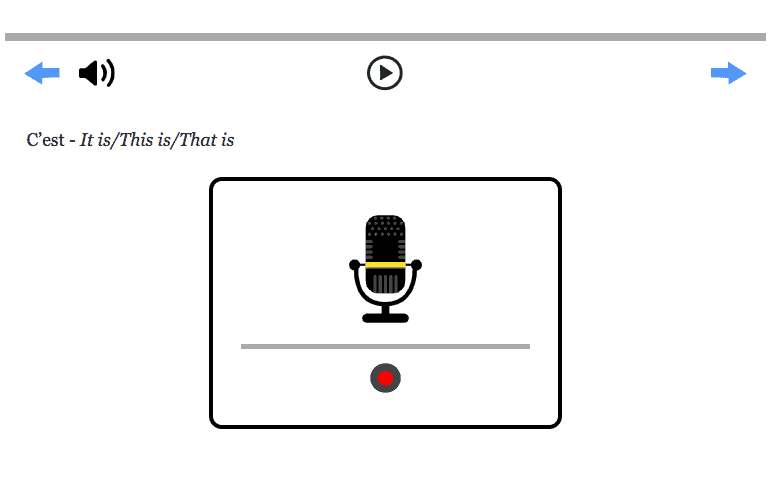
The pronunciation section of the episode is the first time you’re prompted to do more than listen and read the material.
Here, you’ll find around 5 or 6 phrases that are recorded. You’re meant to then record yourself saying the same phrase and compare it to the recording by the native French speaker. This can be a very helpful activity for improving your spoken French.
However, there’s another resource called Speechling, which I’d recommend using instead. It does the same thing, though better and with lots more sentences and other features, for free. Plus, if you want feedback on your pronunciation, you can subscribe and submit them to a teacher to be graded.
Quizzes
There are also two quizzes included with each lesson. In these, you’ll be given various fill-in-the-blank questions. It’s helpful that they use the interactive transcripts that allow you to look up the meaning of some of the more difficult words in the sentence.
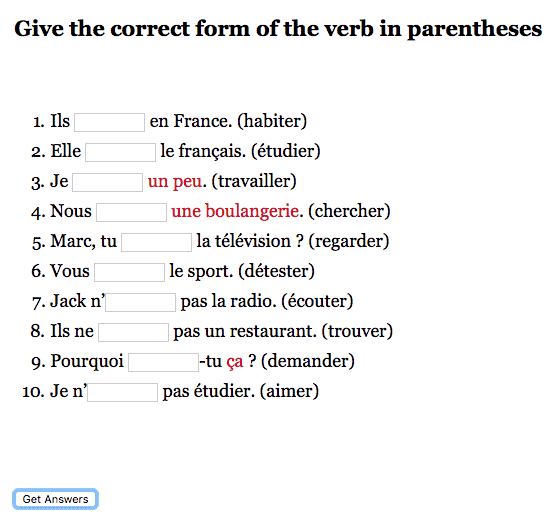
Closing
This is just a short (1 minute or so) narration wrapping up the lesson.
Final thoughts on G.U.T.S.
Although I’m a huge fan of the materials available at the intermediate level of News in Slow French, I’m a bit less enthusiastic about their beginner course.
That’s not to say it’s a bad course; it’s definitely not bad at all. I like how they arranged the lessons to resemble an act in a play, with characters that you get to know throughout the story. The content is structured well, with each episode building on what came before and increasing the ratio of French to English used.
However, I wish it were a little less passive. The majority of the time, you’ll only be listening to the material, and outside of the pronunciation and grammar quizzes, you aren’t asked to use much French.
By contrast, with Pimsleur, you constantly need to think and speak French. Or, with Coffee Break French, you’ll be prompted to put together words and sentences, forcing you to engage with the lessons more.
So, although I’m not enamored with the G.U.T.S. course, it’s not bad. You can also try out the first five lessons for free and see if it fits your preferred learning style.
Pronunciation Course
This course is an eight-part video series in which a linguist provides in-depth instruction for how to go about practicing pronunciation.

The host in these videos is a skilled speaker, which helps to make the lessons engaging, and the information provided is truly valuable.
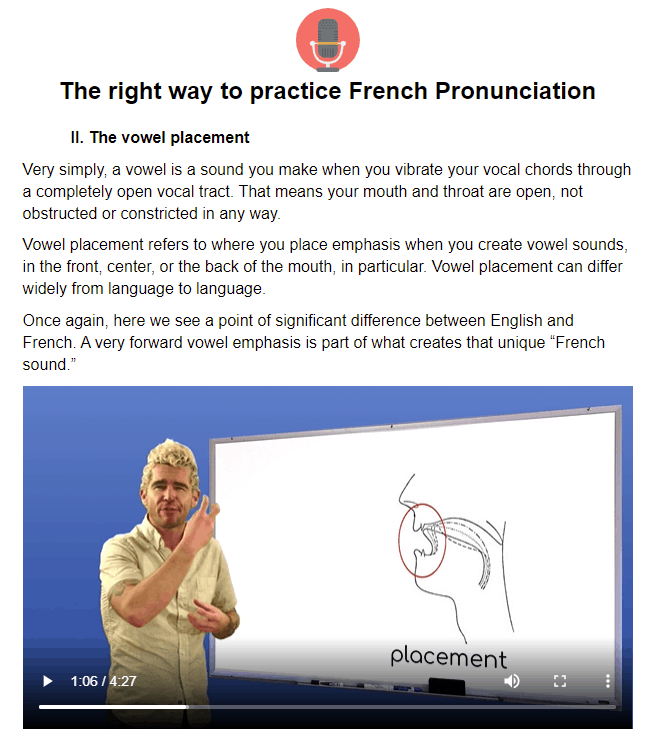
The course provides both theoretical and practical information, and it draws heavily on the similarities and differences between French and English to help with explanations. A large part of the course is learning how to practice pronunciation.
At the end of the course, you’ll have access to both intermediate and advanced pronunciation practice by way of recording yourself while focusing on specific elements of pronunciation.
Grammar Course
The grammar course contains a wide variety of lessons covering many different language points. Each of these lessons features dialogues, a grammar lesson, quizzes, audio narration, and an interactive transcript.

Grammar Dialogues
If you weren’t told that this section is about grammar, you’d probably never realize it’s a grammar lesson. The hosts don’t spend this part of the lesson explaining grammar points to you. Instead, they simply have a discussion about some interesting aspect of French culture, history, or a story.
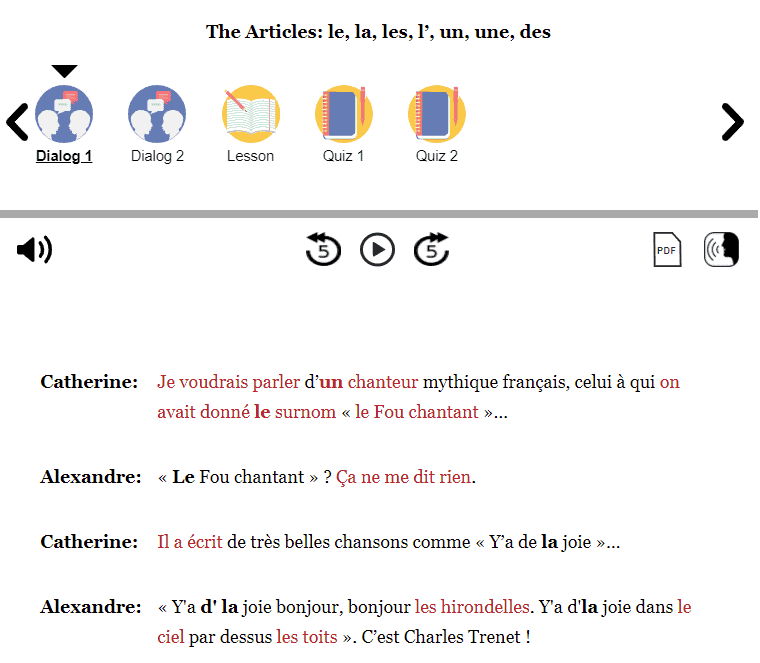
So, what does this have to do with grammar?
At the beginning of this section, you’re told what the grammar focus will be. Then, throughout the course of the discussion, that grammar point is used repeatedly in a completely natural way.
In fact, it’s very similar to how grammar is taught with Grammar Hero – a resource that I like but may be a bit too expensive.
Then, if you look at the transcript, each time the grammar point was used, you’ll see that it has been written in bold. This makes it easier to spot the grammar point used naturally.
Grammar Lesson
While the audio dialogues of the grammar section are very unique, the grammar lessons are much more similar to traditional learning materials. In fact, this part would look at home within a textbook.
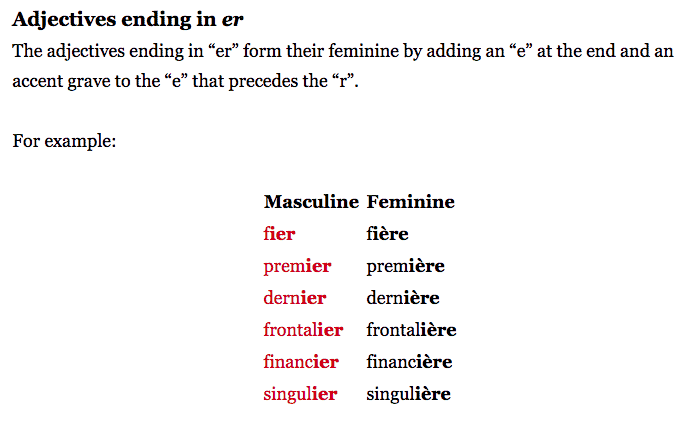
Basically, you’re given an explanation of how the grammar point works with examples.
You could find this elsewhere and probably even for free online, but the other components of Slow News in French are really great.
Plus, it’s nice to have the grammar lesson tie into the audio episode without needing to spend time searching elsewhere for it.
There’s also a huge grammar catalog.
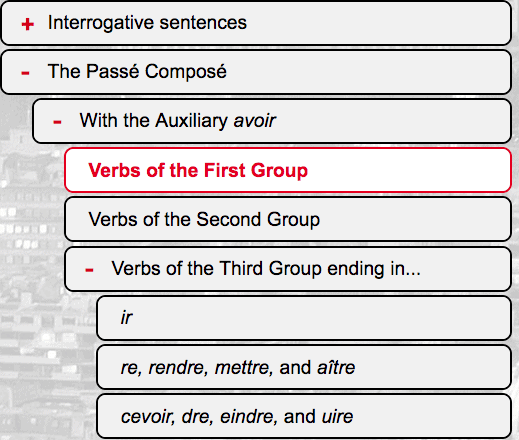
It would be easy to overlook the grammar catalog, but it’s actually one of the reasons why I’m such a big fan of News in Slow French.
Now, I wouldn’t recommend trying to use this as a replacement to a textbook, but it’s an insanely good supplemental resource.
Because there have been hundreds of episodes of News in Slow French, the grammar catalog has become pretty massive.
Remember how I mentioned that the grammar part of the audio lessons didn’t really feel like a grammar lesson at all? Well, it’s the same for all of these lessons in the grammar catalog.
So, instead of looking at it as only a resource to learn grammar, it’s more of a place to improve your listening, build your vocabulary, and hear interesting discussions. Then, if you feel like digging in deeper, you can read through the grammar lessons and practice with the quizzes.
I really love how News in Slow French teaches grammar. You first notice it being used, then learn why it’s used that way, then practice it on your own. It’s a super-effective cycle.
Grammar Quizzes
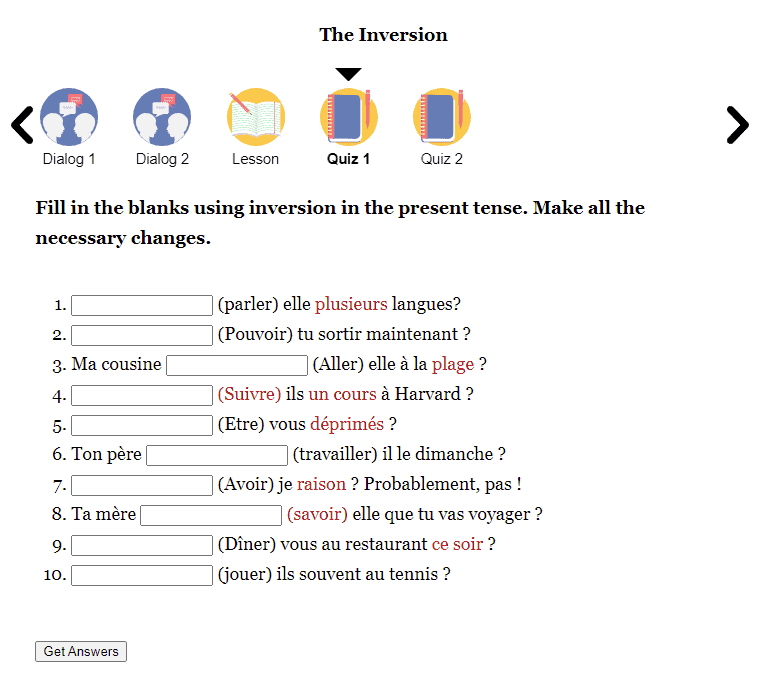
As part of each grammar lesson, you’ll find interactive grammar quizzes. These have a number of fill in the blank questions designed to help you practice that grammar point.
This is really useful since to really master the grammar point, you have to actually be able to use it yourself. If you get stuck, you can check the answers as well.
It’s also pretty nice that they’re written with the interactive transcripts so you can get translations of the more challenging words.
Expressions Course
This course is similar to the grammar course in that it features interactive transcripts, dialogues, and lessons. There are no quizzes in this course, but there is a pronunciation section.

Expression Dialogues
The expression dialogues are probably my favorite part of News in Slow French.
When most resources teach expressions in a foreign language, they usually just give a rough translation and then some examples of when it might be used. That’s not what happens here.
Much like the grammar lessons, the expression is mentioned at the beginning of this section, and that’s pretty much it. The hosts then go on into a discussion about some completely unrelated topic, which is almost always interesting and often teaches you about French culture in a roundabout way.
Then, during their conversation, you’ll hear the expression used several different times. It never feels like they’re trying to teach it; instead, it’s simply a suitable moment for that expression to be used. It’s the most natural way of teaching expressions that I’ve come across.
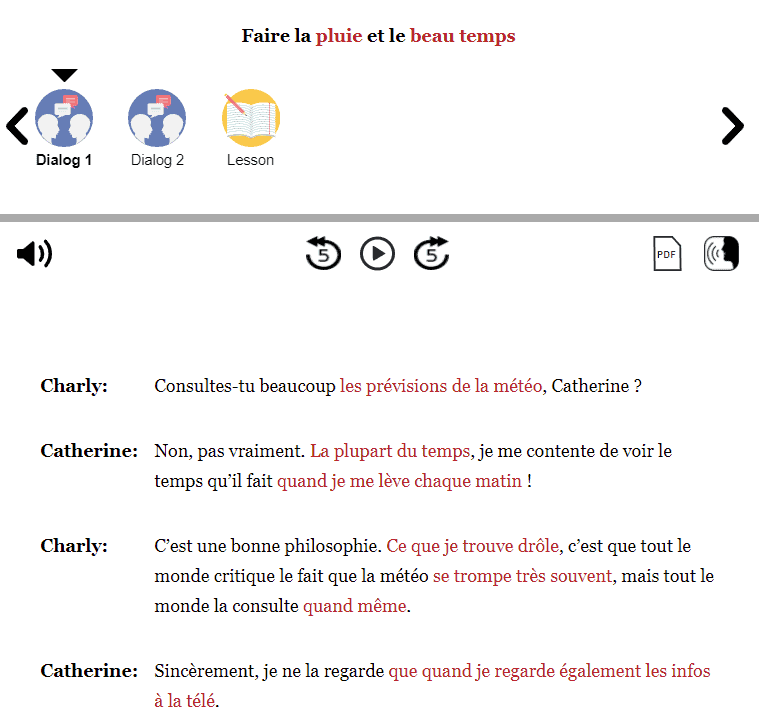
It really doesn’t feel like you’re studying expressions at all. Rather, the experience is very similar to listening to the news stories, where you’re practicing your French by listening to interesting content instead of forcing yourself to study.
Expression Lesson
Like most of News in Slow French, I came away really impressed by the expressions lessons. Again, they don’t teach expressions in the basic, common way that most other resources do.
From the expressions dialogue, you only saw how the expression was used in a natural manner but weren’t explicitly taught much about it. This section explains it much more but in a fun way.
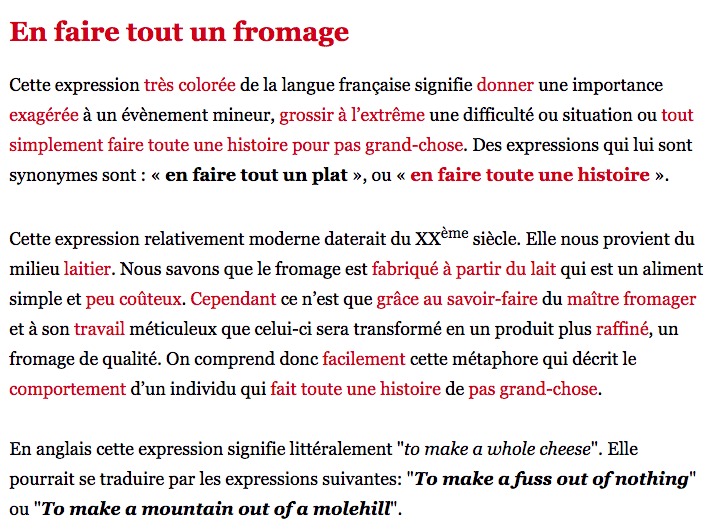
Similar to the grammar lessons, there’s no audio, but this part is quite unique. For starters, it’s written nearly entirely in French. It explains how the expression is used, provides English equivalents, gives example sentences, and even goes into the history of how the expression became prevalent, which I found fascinating.
There’s also a huge expressions catalog
Much like the grammar catalog, the expressions catalog is massive. It’s definitely worth spending a lot of time digging through.
Each of the expressions found in this section also includes the accompanying dialogue and lesson.
For most people, listening to old news stories isn’t the most exciting thing imaginable. But, the items found in this grammar catalog are timeless. Lessons from years ago are still as interesting to listen to today as the day they were recorded.
This is a super valuable part of News in Slow French and shouldn’t be overlooked.
Beginner and Intermediate News Stories
Although I wasn’t the biggest fan of the beginner G.U.T.S. course, I can enthusiastically recommend the beginner and intermediate news materials.
The intermediate news stories are actually where News in Slow French got started (hence the name), so not surprisingly, it’s also their strongest offering. It’s a great way for intermediate-level students who aren’t quite ready for native materials to study French in a way that’s far more fun than most other resources.
The beginner news stories are the site’s most recent production, and they also maintain a high standard of quality.

The audio episodes are the heart of News in Slow French. As is obvious from the name, the main draw is that they contain current events narrated and discussed at a slower pace, making them easier for French learners to follow along with.
The news stories are super interesting, highlighting the most important current events, as well as some smaller French-specific stories. The two hosts narrate a news story, then discuss it, adding in their opinions and additional information, entirely in French. Each news story lasts around 3-5 minutes.
Interactive News Transcripts
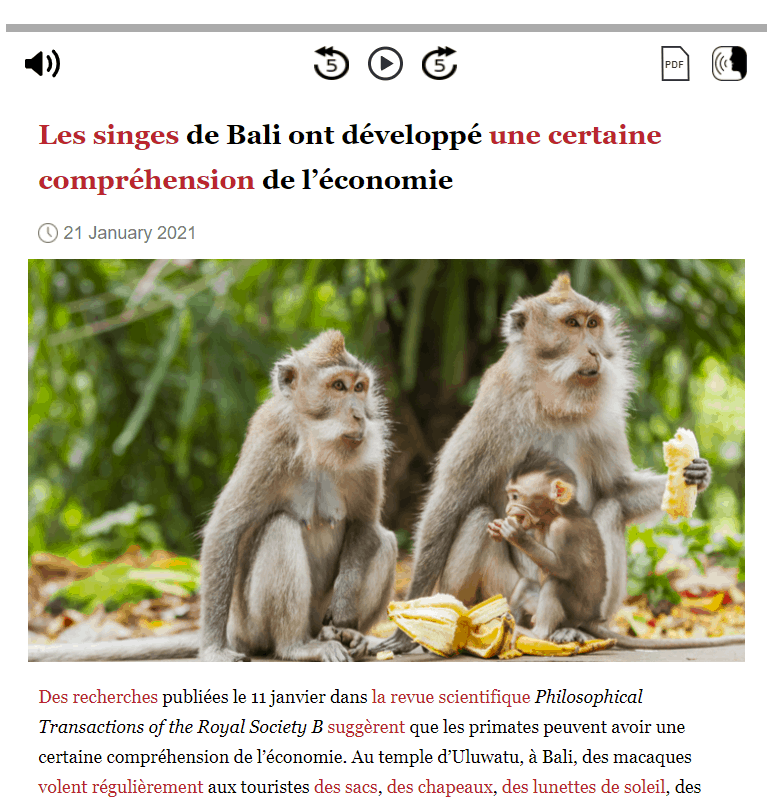
Since many of the news stories can cover rather complicated topics, there are bound to be parts that you need to reference the transcript to fully understand.
The more challenging parts have been written in red. If you then hover over those parts, you’ll see an English translation.
I really like that this isn’t only translations of individual words, but also includes phrases as well. This is a nice feature because sometimes you may understand all the words in a phrase, but the meaning of the phrase could still be a bit unclear.
The lessons in the beginner news stories make the most use of the red, translation-ready text: some of the lessons are mostly in red.
Pronunciation Practice
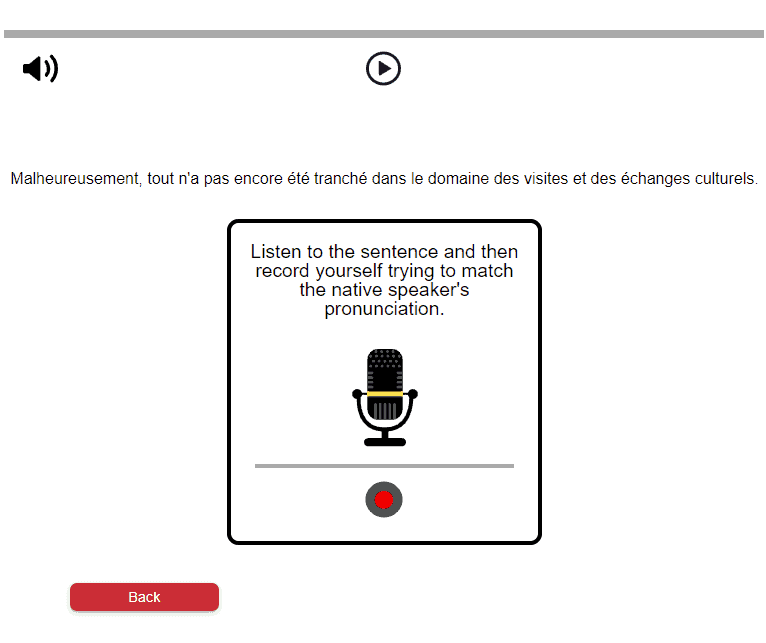
This is probably the least exciting part of the news stories. Basically, you’ll be given some phrases, a recording by a native speaker, and then record yourself saying the same sentence.
While it’s a very useful exercise that I recommend doing, I think Speechling does the same thing better and for free. Plus, you can get feedback on your pronunciation if you’re willing to pay.
Final Thoughts
I’m a huge fan of the intermediate materials available on News in Slow French.
Because they’ve been around a while, the catalog for these lessons is huge and those components of the lessons age extremely well.
The beginner news stories also seem to be well done, but the catalog is much, much smaller.
One of the best ways to get yourself studying regularly is to find methods that are fun to use. News in Slow French is great for this.
Advanced
The final product available on News in Slow French is their advanced news series.
Similar to the beginner course, I think it’s alright but I’m not nearly as enthusiastic about it as I am the episodes at the intermediate level. That said, I can definitely see some people finding a lot of value in using it.
At the intermediate level, the audio is quite a bit slower than a natural pace. The hosts speak much more quickly at the advanced level, though it might be slightly slower than you’d find on a French news show. Because the hosts speak quicker, they can also go deeper while discussing the current events.
However, the real benefit of the advanced material is that you can use their interactive transcripts.
For those that aren’t quite ready for native speaking news shows, this can be a nice stepping stone. Still, I’d imagine if you were to do some digging, that there’s a good chance you could find a news program that also has transcripts available online.
I really loved the grammar and expressions catalogs, especially for intermediate learners. The content would be equally valuable to advanced learners if it weren’t for the fact that they’re spoken at a slower pace.
I could see it being a little frustrating for advanced students who are nearly fluent to go back and use those resources where French is spoken much slower.
Final Thoughts
Although I’m not a huge fan of what’s included in the advanced level of News in Slow French, it’s not as if the materials are bad.
However, for those considering trying this level, I’d suggest trying to watch native news programs on their own first. If those are too frustrating, then it may be worth subscribing.
Series
They also have a section called “series” which allows you to listen and read along to both fictional and nonfictional stories broken out into different chapters or parts. There’s an interesting range of material here that could appeal to many: meditate in French, learn about famous French actresses, experience French history, and more.
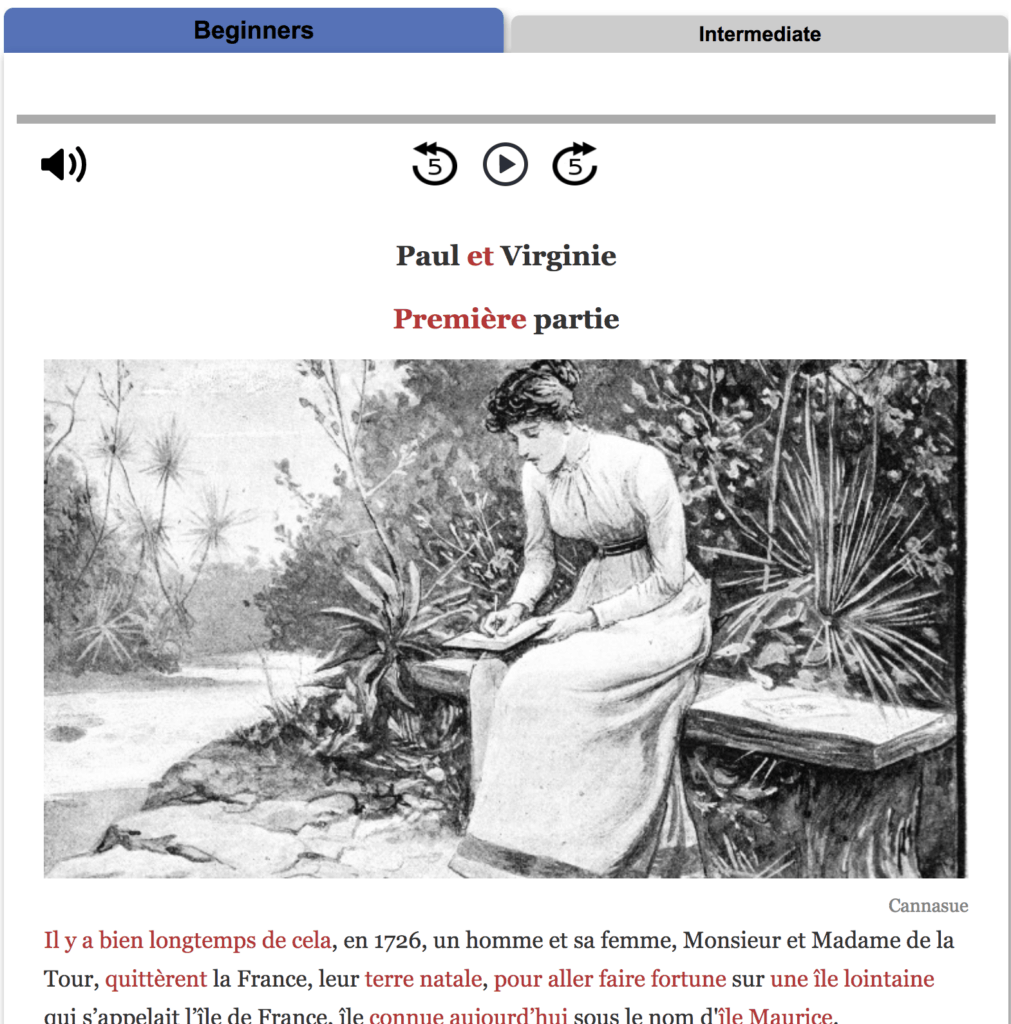
If you are beyond a total beginner and want to study with something that’s a little more entertaining than some of the news content then this section may be worth checking out. The current content ranges from beginner to advanced so you can try it out no matter what your level is.
L360 App
News in Slow French is also available as an app for Android or Apple. It contains all of the weekly news stories and series, but you’ll have to use the browser version of the resource for access to courses.
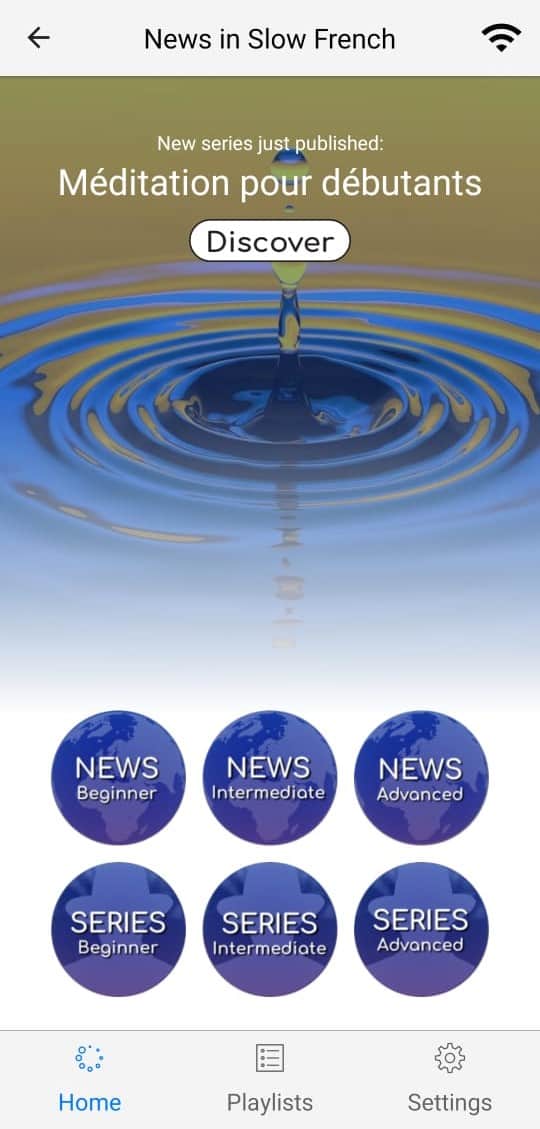
While fairly basic, the app provides all you really need to get convenient practice on a mobile device. You can also create playlists and listen to content offline.
Pricing
There’s only one subscription option, and it’s $19.90 per month. New subscribers get a 7-day free trial, but you need a credit card to sign up.
The subscription includes all of the material at all three difficulty levels and can be canceled at any time. After you cancel your subscription, you’ll still have access to the program until the end of the billing cycle.
For those that don’t like recurring subscriptions, there’s an option to prepay for up to 12 months at a time using a gift subscription, but there’s no discount on the monthly price. Use this method if you want to avoid paying for a monthly subscription you forgot about!
News in Slow French is a lot of fun
I think both the beginner and advanced levels of News in Slow French are pretty good, but not amazing. However, I absolutely love the materials included at the intermediate level.
You don’t need to take my word for it though, the first five lessons of the beginner course are available for free, as well as an intermediate and advanced episode.
I’d also recommend supplementing News in Slow French with regular lessons with a tutor on italki. Lessons are really affordable, and it’s possible to find language exchange partners for free. Additionally, you can get feedback on your writing using their ‘Exercise’ section in the app.
All that said, News in Slow French is among the most fun resources you’ll find.

